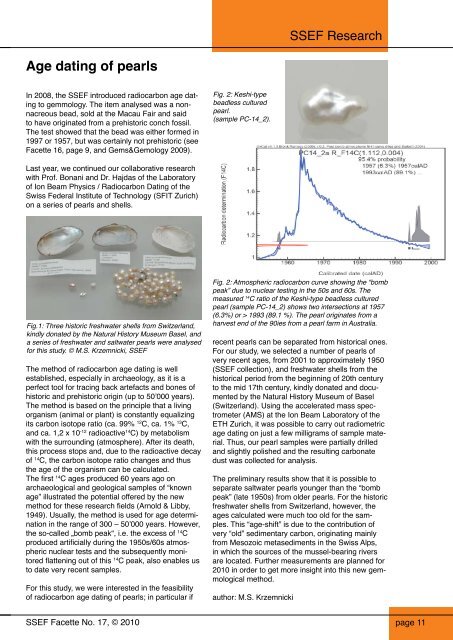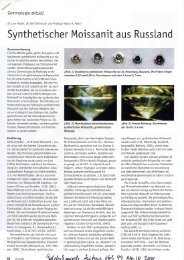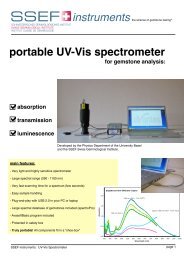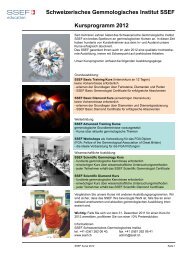SSEF FACETTE No. 17
SSEF FACETTE No. 17
SSEF FACETTE No. 17
You also want an ePaper? Increase the reach of your titles
YUMPU automatically turns print PDFs into web optimized ePapers that Google loves.
Age dating of pearls<br />
In 2008, the <strong>SSEF</strong> introduced radiocarbon age dating<br />
to gemmology. The item analysed was a nonnacreous<br />
bead, sold at the Macau Fair and said<br />
to have originated from a prehistoric conch fossil.<br />
The test showed that the bead was either formed in<br />
1997 or 1957, but was certainly not prehistoric (see<br />
Facette 16, page 9, and Gems&Gemology 2009).<br />
Last year, we continued our collaborative research<br />
with Prof. Bonani and Dr. Hajdas of the Laboratory<br />
of Ion Beam Physics / Radiocarbon Dating of the<br />
Swiss Federal Institute of Technology (SFIT Zurich)<br />
on a series of pearls and shells.<br />
Fig.1: Three historic freshwater shells from Switzerland,<br />
kindly donated by the Natural History Museum Basel, and<br />
a series of freshwater and saltwater pearls were analysed<br />
for this study. © M.S. Krzemnicki, <strong>SSEF</strong><br />
The method of radiocarbon age dating is well<br />
established, especially in archaeology, as it is a<br />
perfect tool for tracing back artefacts and bones of<br />
historic and prehistoric origin (up to 50’000 years).<br />
The method is based on the principle that a living<br />
organism (animal or plant) is constantly equalizing<br />
its carbon isotope ratio (ca. 99% 12 C, ca. 1% 13 C,<br />
and ca. 1,2 x 10 -12 radioactive 14 C) by metabolism<br />
with the surrounding (atmosphere). After its death,<br />
this process stops and, due to the radioactive decay<br />
of 14 C, the carbon isotope ratio changes and thus<br />
the age of the organism can be calculated.<br />
The first 14 C ages produced 60 years ago on<br />
archaeological and geological samples of “known<br />
age” illustrated the potential offered by the new<br />
method for these research fields (Arnold & Libby,<br />
1949). Usually, the method is used for age determination<br />
in the range of 300 – 50’000 years. However,<br />
the so-called „bomb peak“, i.e. the excess of 14 C<br />
produced artificially during the 1950s/60s atmospheric<br />
nuclear tests and the subsequently monitored<br />
flattening out of this 14 C peak, also enables us<br />
to date very recent samples.<br />
For this study, we were interested in the feasibility<br />
of radiocarbon age dating of pearls; in particular if<br />
<strong>SSEF</strong> Facette <strong>No</strong>. <strong>17</strong>, © 2010<br />
Fig. 2: Keshi-type<br />
beadless cultured<br />
pearl.<br />
(sample PC-14_2).<br />
<strong>SSEF</strong> Research<br />
Fig. 2: Atmospheric radiocarbon curve showing the “bomb<br />
peak” due to nuclear testing in the 50s and 60s. The<br />
measured 14 C ratio of the Keshi-type beadless cultured<br />
pearl (sample PC-14_2) shows two intersections at 1957<br />
(6.3%) or > 1993 (89.1 %). The pearl originates from a<br />
harvest end of the 90ies from a pearl farm in Australia.<br />
recent pearls can be separated from historical ones.<br />
For our study, we selected a number of pearls of<br />
very recent ages, from 2001 to approximately 1950<br />
(<strong>SSEF</strong> collection), and freshwater shells from the<br />
historical period from the beginning of 20th century<br />
to the mid <strong>17</strong>th century, kindly donated and documented<br />
by the Natural History Museum of Basel<br />
(Switzerland). Using the accelerated mass spectrometer<br />
(AMS) at the Ion Beam Laboratory of the<br />
ETH Zurich, it was possible to carry out radiometric<br />
age dating on just a few milligrams of sample material.<br />
Thus, our pearl samples were partially drilled<br />
and slightly polished and the resulting carbonate<br />
dust was collected for analysis.<br />
The preliminary results show that it is possible to<br />
separate saltwater pearls younger than the “bomb<br />
peak” (late 1950s) from older pearls. For the historic<br />
freshwater shells from Switzerland, however, the<br />
ages calculated were much too old for the samples.<br />
This “age-shift” is due to the contribution of<br />
very “old” sedimentary carbon, originating mainly<br />
from Mesozoic metasediments in the Swiss Alps,<br />
in which the sources of the mussel-bearing rivers<br />
are located. Further measurements are planned for<br />
2010 in order to get more insight into this new gemmological<br />
method.<br />
author: M.S. Krzemnicki<br />
page 11


